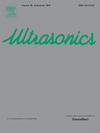Machine learning inverse surrogates for damage identification in plates based on Lamb waves
IF 4.1
2区 物理与天体物理
Q1 ACOUSTICS
引用次数: 0
Abstract
This work proposes a black-box purely data-driven strategy for structural damage identification concerning localized damaged regions in plate-like structures. The proposed strategy is based on Convolution Neural Networks in the framework of a supervised learning regression task. The relationships between the estimated and target damage parameters are investigated, focusing on the physical interpretability of the damage recovery results. The positional parameters are found to be much more easily estimated than those describing damage size and damage intensity, in accordance with the literature where similar parameterizations are considered. The high accuracy with which it is possible to estimate the positional parameters explains, in part, the many successful approaches found in literature where damage localization is treated as a classification problem. Some numerical analyses are shown for a convolutional neural network architecture with diverse damage scenarios in an elastic plate considering Lamb waves, three actuators and 16 sensors. The first surrogate inverse model training considers homogeneous material properties and the second one considers non-homogeneous material properties. Results are evaluated using a set of overlap metrics, which help identify both the accuracy and the limitations of the inverse surrogates in damage recovery. The inverse surrogate trained with non-homogeneous material properties proved robust with respect to system variability.
基于Lamb波的板损伤识别机器学习逆代理。
本研究提出了一种纯数据驱动的黑箱结构损伤识别策略,用于板状结构中局部损伤区域的损伤识别。提出的策略是基于监督学习回归任务框架下的卷积神经网络。研究了估计损伤参数与目标损伤参数之间的关系,重点研究了损伤恢复结果的物理可解释性。与考虑类似参数化的文献一致,发现位置参数比描述损伤大小和损伤强度的参数更容易估计。在一定程度上,估计位置参数的高精度解释了在文献中发现的许多成功的方法,其中损伤定位被视为分类问题。对考虑兰姆波、3个致动器和16个传感器的弹性板损伤情况下的卷积神经网络结构进行了数值分析。第一个代理逆模型训练考虑均匀材料特性,第二个考虑非均匀材料特性。使用一组重叠指标对结果进行评估,这有助于确定反向代理在损害恢复中的准确性和局限性。用非均匀材料特性训练的逆代理证明了对系统可变性的鲁棒性。
本文章由计算机程序翻译,如有差异,请以英文原文为准。
求助全文
约1分钟内获得全文
求助全文
来源期刊

Ultrasonics
医学-核医学
CiteScore
7.60
自引率
19.00%
发文量
186
审稿时长
3.9 months
期刊介绍:
Ultrasonics is the only internationally established journal which covers the entire field of ultrasound research and technology and all its many applications. Ultrasonics contains a variety of sections to keep readers fully informed and up-to-date on the whole spectrum of research and development throughout the world. Ultrasonics publishes papers of exceptional quality and of relevance to both academia and industry. Manuscripts in which ultrasonics is a central issue and not simply an incidental tool or minor issue, are welcomed.
As well as top quality original research papers and review articles by world renowned experts, Ultrasonics also regularly features short communications, a calendar of forthcoming events and special issues dedicated to topical subjects.
 求助内容:
求助内容: 应助结果提醒方式:
应助结果提醒方式:


